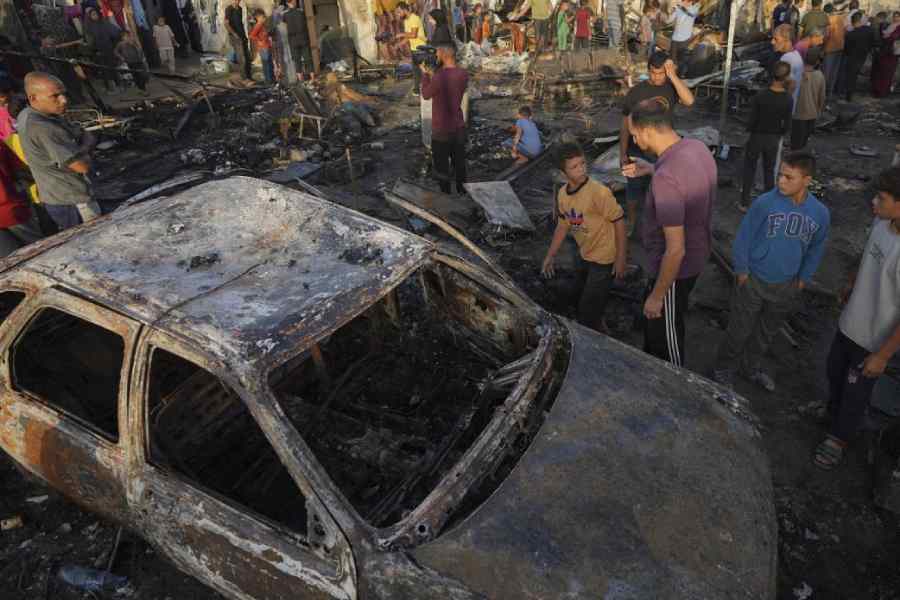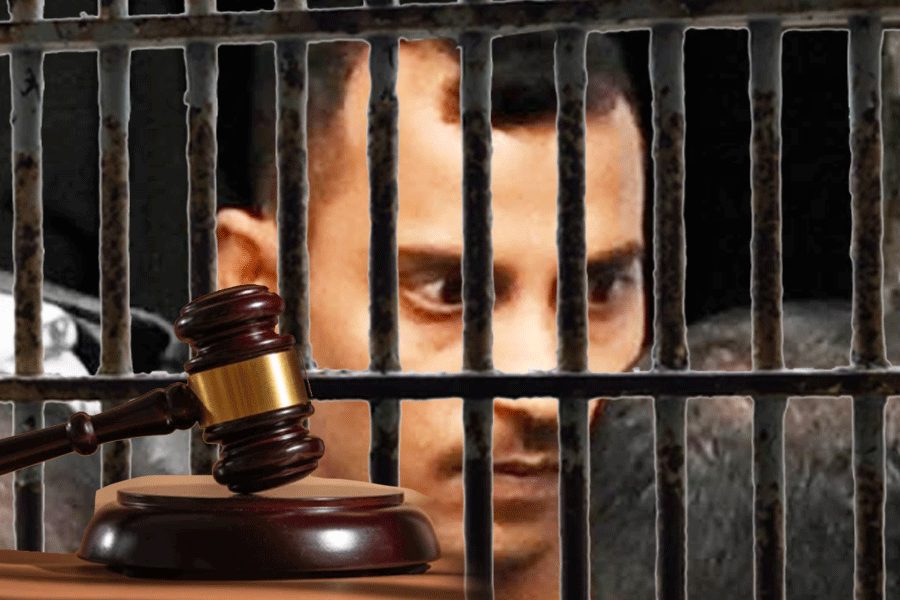After Israeli soldiers found Mohammed Shubeir hiding with his family in early March, they detained him for roughly 10 days before releasing him without charge, he said.
During that time, Shubeir said, the soldiers used him as a human shield.
Shubeir, then 17, said he was forced to walk handcuffed through the empty ruins of his hometown, Khan Younis, in southern Gaza, searching for explosives set by Hamas. To avoid being blown up themselves, the soldiers made him go ahead, Shubeir said.
In one wrecked building, he stopped in his tracks: Running along the wall, he said, was a series of wires attached to explosives.
“The soldiers sent me like a dog to a booby-trapped apartment,” said Shubeir, a high school student. “I thought these would be the last moments of my life.”
An investigation by The New York Times has found that Israeli soldiers and intelligence agents, throughout the war in Gaza, have regularly forced captured Palestinians like Shubeir to conduct life-threatening reconnaissance missions to avoid putting Israeli soldiers at risk on the battlefield.
While the extent and scale of such operations are unknown, the practice, illegal under both Israeli and international law, has been used by at least 11 squads in five cities in Gaza, often with the involvement of officers from Israeli intelligence agencies.
Palestinian detainees have been coerced to explore places in Gaza where the Israeli military believes that Hamas militants have prepared an ambush or a booby trap. The practice has gradually become more widespread since the start of the war last October.
Detainees have been forced to scout and film inside tunnel networks where soldiers believed fighters were still hiding. They have entered buildings rigged with mines to find hidden explosives.
The detainees have been told to pick up or move objects like generators and water tanks that Israeli soldiers feared concealed tunnel entrances or booby traps.
The Times interviewed seven Israeli soldiers who observed or participated in the practice and presented it as routine, commonplace and organised, conducted with considerable logistical support and the knowledge of superiors on the battlefield. Many of them said the detainees were handled and often transported between the squads by officers from Israel’s intelligence agencies, a process that required coordination between battalions and the awareness of senior field commanders. And though they served in different parts of Gaza at different points in the war, the soldiers largely used the same terms to refer to human shields.
The Times also spoke to eight soldiers and officials briefed on the practice who all spoke on the condition of anonymity to discuss a military secret. Maj. Gen. Tamir Hayman, a former chief of military intelligence who is routinely briefed by top military and defence officials on the conduct of the war, confirmed the use of one version of the practice, saying that some detainees had been coerced into entering tunnels while others had volunteered to accompany troops and act as their guides, in the hope of gaining favour with the military. And three Palestinians gave on-the-record accounts about being used as human shields.
The Times found no evidence of any detainees being harmed or killed while being used as human shields. In one case, an Israeli officer was shot and killed after a detainee sent to search a building either did not detect or failed to report a militant hiding there.
The Israeli military said in a statement that its “directives and guidelines strictly prohibit the use of detained Gaza civilians for military operations”. It added that the accounts of the Palestinian detainees and soldiers interviewed by The Times would be “examined by the relevant authorities”.
International law forbids the use of civilians or combatants as a shield against attack. It is also illegal to send captured combatants to places where they would be exposed to fire, or to force civilians to do anything related to the conduct of military operations.
While the laws are vaguer about the rights of people detained during conflicts with a nonstate actor like Hamas, it is illegal to force Palestinian detainees to explore dangerous places “regardless of whether those detainees are civilians or members of the fighting wing of Hamas”, said Lawrence Hill-Cawthorne, a professor at the University of Bristol in England and an expert on laws governing detention in conflicts with non-state actors. The Israeli military employed a similar practice, known as the “neighbour procedure”, in Gaza and the West Bank in the early 2000s. Soldiers would force Palestinian civilians to approach the homes of militants to persuade them to surrender.
That procedure was banned in 2005 by Israel’s Supreme Court, in an expansive ruling that also outlawed the use of human shields in other contexts. The court’s president, Aharon Barak, ruled that a resident of an occupied territory “should not be brought, even with his consent, into an area where a military operation is taking place”.
The power imbalance between soldier and civilian, his decision said, meant that no one could be considered to have volunteered for such a task. Soldiers should also not ask civilians to do things they assumed were safe, the ruling added, given that “this assumption is sometimes unfounded”.
The war in Gaza began last October when Hamas and its allies committed widespread atrocities in Israel before retreating into underground tunnels to escape a devastating Israeli counterattack that has killed tens of thousands of Palestinians.
Accused of acting without enough concern for civilian casualties, Israel has defended itself by saying that Hamas embeds its fighters and weapons in civilian areas, effectively using entire communities as human shields. Israeli soldiers have used human shields in a different way.
Prof. Michael N. Schmitt, a scholar at West Point who has studied the use of human shields in armed conflicts, said he was unaware of another military routinely using civilians, prisoners of war or captured terrorists for life-threatening reconnaissance missions in recent decades. Military historians say the practice was used by US forces in Vietnam. “In most cases,” Schmitt said, “this constitutes a war crime.”
The soldiers who spoke to The Times said they began using the practice during the current war because of a desire to limit the risks to infantry.
Some of the soldiers who saw or participated in the practice found it deeply troubling, prompting them to take the risk of discussing a military secret with a journalist. Two were connected to The Times by Breaking the Silence, an independent watchdog that gathers testimony from Israeli soldiers.
Two soldiers said that members of their squads, which each comprised roughly 20 people, expressed opposition to commanders. Soldiers said some low-ranking officers tried to justify the practice by claiming, without proof, that the detainees were terrorists rather than civilians held without charge.
They said they were told that the lives of terrorists were worth less than those of Israelis — even though officers often concluded their detainees did not belong to terrorist groups and later released them without charge, according to an Israeli soldier and the three Palestinians who spoke to The Times.
One Israeli squad forced a crowd of displaced Palestinians to walk ahead for cover as it advanced towards a militant hide-out in central Gaza City, according to Jehad Siam, 31, a Palestinian graphic designer who was part of the group.
“The soldiers asked us to move forward so that the other side wouldn’t shoot back,” Siam said. Once the crowd reached the hide-out, the soldiers emerged from behind the civilians and surged inside the building, Siam said. After seemingly killing the militants, Siam said, the soldiers let the civilians go unharmed.
Searching at gunpoint
Hamas has turned large parts of Gaza into a labyrinth of booby traps and hidden tunnel networks, rigging civilian homes and institutions with explosive traps or using them as temporary military bases and arms caches.
After invading Gaza in late October, Israeli soldiers said they found they were often at most risk when entering homes or tunnel entrances possibly lined with traps. To combat that threat, they used drones and sniffer dogs to scout a location before entering.
When no dogs or drones were available or when officers believed a human would be more effective, they sometimes sent in Palestinians.
Basheer al-Dalou, a pharmacist from Gaza City, said he was forced to act as a human shield on the morning of November 13, after being captured at his home. al-Dalou, now 43, had fled the neighbourhood with his wife and four sons weeks earlier, but had briefly returned to fetch some basic supplies, even though the neighbourhood was a battlefield.
The soldiers ordered al-Dalou to strip to his underwear, then handcuffed and blindfolded him, he said in an interview in Gaza after his release without charge.
After being interrogated about Hamas activities in the area, al-Dalou said, he was ordered by the soldiers to enter the backyard of a nearby five-storey home. The yard was littered with debris, including birdcages, water tanks, gardening tools, broken chairs, shattered glass and a large generator, he said.
“Behind me, three soldiers pushed me forward violently,” al-Dalou recalled. “They were afraid of potential tunnels under the ground or explosives hidden under any object there.” Walking barefoot, he cut his feet on the shards of glass, he said.
After being provided with the location, date and description of al-Dalou’s experience, the military declined to comment. His description echoed accounts of similar episodes from 10 Israeli soldiers who also described witnessing or being briefed on how Palestinian detainees had been used to scour buildings and yards.
Roughly seven or eight soldiers hid behind the rubble of the yard’s shattered wall, taking cover in case al-Dalou stumbled across a bomb, he said. One of them directed him using a loudspeaker.
With his hands tied behind his back, he said, al-Dalou was ordered to walk around the yard, kicking bricks, scraps of metal and empty boxes. At some point, the soldiers tied his hands in front of him so that he could more easily shunt suspicious objects in his path.
Then something stirred suddenly from behind a generator in the yard. The soldiers started firing towards the source of the noise, narrowly missing al-Dalou, he said. It turned out to be a cat.
Next, the soldiers ordered him to try to shift the generator, suspecting that it concealed a tunnel entrance, he said. After al-Dalou hesitated, fearing that Hamas fighters might emerge from within, a soldier hit his back with his rifle butt, al-Dalou said.
Later that day, he said, he was ordered to walk in front of an Israeli tank as it advanced towards a mosque where soldiers worried they would encounter militants. Some of his neighbours were taken to look for tunnel entrances at a nearby hospital, Al-Rantisi, and he has not seen them since, he said.
That evening, he said, he was taken to a detention centre in Israel. Given his experiences that day, he said, the transfer felt like a small blessing, even though he expected to face abuse inside Israeli jails.
“I was over the moon at that moment,” al-Dalou remembered thinking. “‘I will leave this danger zone for a safer place inside the Israeli prisons.’”
UN compound
In early February, the Israeli military captured the Gaza City headquarters of UNRWA, the main UN agency for Palestinian refugees.
Discovering that Hamas’s tunnel network extended beneath the compound, military engineers drilled into the ground to create new access points.
At one point, the engineers lowered a camera into the tunnels using a rope, so that they could more clearly see what was inside, according to a soldier involved in the operation. Watching a live feed from the camera, the engineers saw a man inside the tunnel, probably a Hamas operative.
Concluding that Hamas fighters were still using the tunnel, the officers at the site decided that they would send a Palestinian with a bodycam to explore it further, instead of Israeli engineers, the soldier said.
Two other soldiers confirmed that this soldier’s account generally matched how engineers typically deployed Palestinians in tunnels. This soldier’s description of the site also matched that of a reporter for The Times who visited it shortly afterwards with a military escort but did not see any Palestinians.
After being provided with the location, date and description of the soldier’s experience, the military declined to comment.
At first, the officers considered deploying one of the several dozen Palestinian civilians who had been captured in the area and were being held until the operation ended, the soldier said.
Eventually, the officers decided to send what they called a “wasp”, or a Palestinian detained in Israel, for reasons that were not clear to the soldier. That set off a more complicated process that took several days and considerable coordination with other units to complete, the soldier said.
Throughout the war, soldiers across different units generally referred to the detainees by the same terms. A “wasp” generally meant people brought to Gaza from Israel by intelligence officers for brief and specific missions; however, some soldiers said it referred to paid collaborators who voluntarily entered Gaza.
A “mosquito” described detainees who were captured in Gaza and swiftly deployed without being taken to Israel, sometimes for several days.
New York Times News Service











